The oceans have been around for 350 million years and during that time, prehistoric fishes have evolved into a diverse group of creatures. Some of the earliest known fossils of fish date back to a time when the Earth was relatively new, which makes them some of the oldest creatures on our planet.
While some prehistoric fish species may have remained relatively unchanged over this period, others have become quite different. Let’s take a look at the most terrifying prehistoric fishes ever known to humankind:
1Knightia
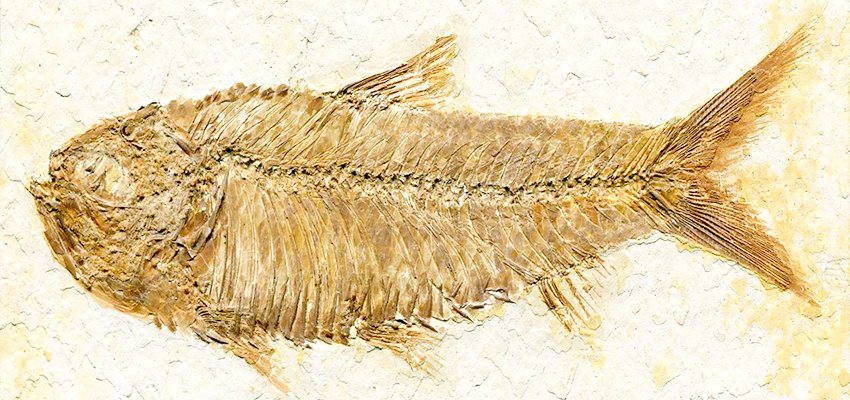
These fish were a freshwater herring whose fossils can be found in the Green River Formation of Wyoming. They existed 50-40 million years ago during the Eocene epoch. Knightia was fairly small, usually measured around 3-5 inches (7.7-12.7 centimeters), and exceptionally large Knightia specimens have been recorded at 11 inches (28 centimeters) in length.
These fish ate little arthropods, algae, and the occasional baby fish or anything they could find their way into their tiny mouths. On the contrary, many larger animals, like fish, birds, snakes, turtles and others would eat these types of fishes due to the abundance of their foods on Earth during that time period.
Suggested by mass deadliness plates and modern dealing of herring these fish lived in large flocks, over vast open water where they were constantly hunted by multiple creatures for food. They are also found as Wyoming’s state fossil.
2Eusthenopteron

Eusthenopteron is a lobe finned fish and it has been traditionally thought that these ancestors of land walking amphibians were capable of pushing the body out the water on their stout and powerful tail. Scientific analysis of the Eusthenopteron fossils showed that it was likely only one species and did not have any particular adaptations to living outside sea water. In this way, this prehistoric fish is considered to be one of the ancestors of a line that spawned amphibians and ultimately allowed vertebrates to start colonizing land.
3Xiphactinus
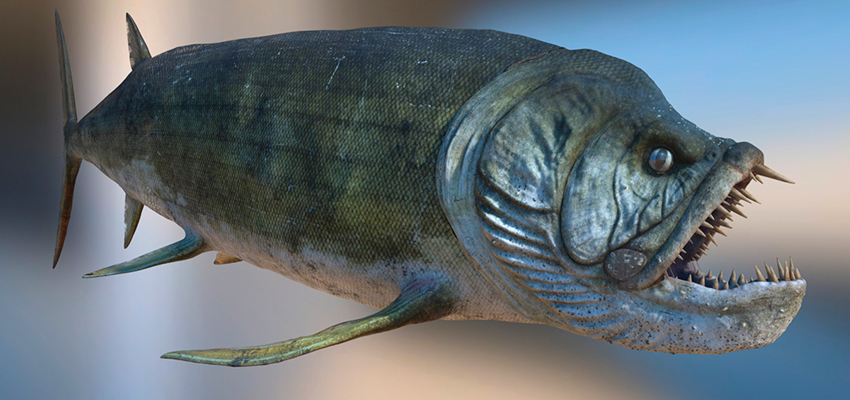
Xiphactinus was a successful, sometimes aggressive, predatory shark that could grow to a certain size. It had sharp needle-like teeth and could swim quickly through the water. With a large body and needle-toothed beaks, This prehistoric sea creature thrived in an ecosystem evolving underwater of the late Cretaceous. Some of these fish appear to have grown so large they troubled other ocean dwellers of the period though it may not be so with those alive today.
It is likely that Xiphactinus died shortly after eating a large prey-such as a Gillicus arctuatis-in its stomach. A number of skeletons of Xiphactinus show evidence of this, with their bellies full to the brim of undigested food. The most famous example is found in Hays, Kansas, at the Sternberg Museum of Natural History; an almost thirteen foot long Xiphactinus had the entire six foot long Gillicus fixed inside his belly!
The newfound species had a long, thin body like a torpedo and could reach speeds of up to 37 miles per hour. Some estimates are that this creature may have preyed on pterosaurs from the water’s surface.
4Coccosteus
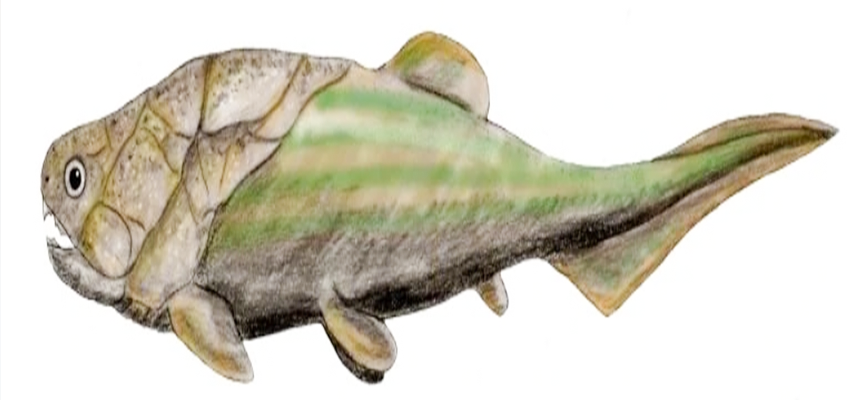
Coccosteus (“Seed Bone”) have been found through Europe and North America. These fossils have been identified as belonging to an arthrodire placoderm, an aquatic vertebrate that existed in the prehistoric period. It is likely that the saltwater would not have made them change their habitat.
A Coccosteus had an external joint between the body and skull, similar to other arthrodires and it also resembles a modern shark. In addition, it has an internal joint that runs between its neck vertebrae and even the back of the skull, allowing the mouth to open wide. Its long jaw allowed Coccosteus to swallow large prey. Its up-and-down movement of the skull, or breathing tube, let water pass through its gills more easily.
5Haikouichthys
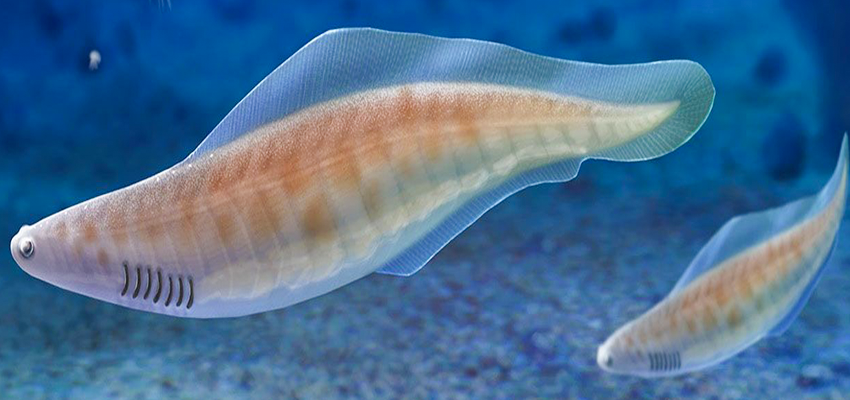
Haikouichthys was a prehistoric fish that lived during the Lower Cambrian period in China. This ocean creature grew to be 1,000 years old and they were some of, if not, the earliest known fish. They had a segmented body with a streamlined tail, a dorsal fin that intersected with the tail and six to nine gills on either side of their bodies. These creatures have been referred to as the ancestor of all vertebrate animals.
They had a primitive backbone to make them more maneuverable than spineless Anomalocaris. Although, size wise these species of fish would fit in your thumbnail if you held them up next to your thumb. Tight or not, these ancestors for all vertebrates were some evolutionary giants that took time to develop into a competitive habitat for future age groups of animals like Haikouichthys.
6Leedsichthys
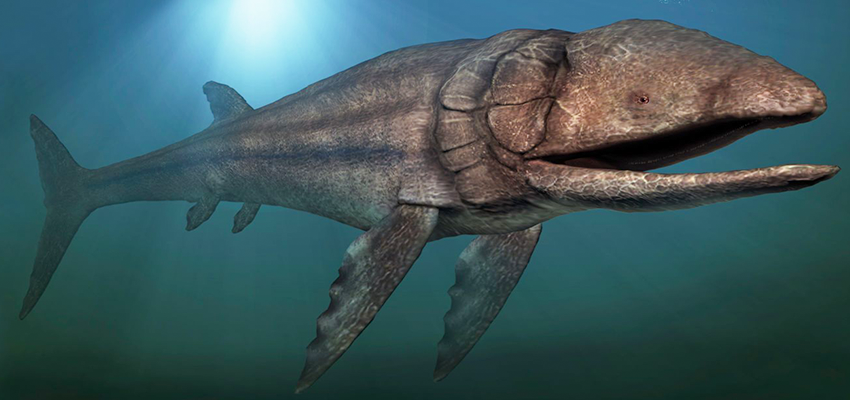
The Leedsichthys was a giant prehistoric fish that lived in the Jurassic ocean, and its large size may have been one of the reasons why previously existing predators weren’t effective against them. On the other hand, we don’t know as much about its fighting technique. As with many filter-feeding big fish, like Leedsichthys, it swam close to the surface with its mouth open ready to feed on small invertebrates and plankton at any time.
This is how and why Leedsichthys got so big—as it had a big mouth for filtering out all types of food and didn’t need to swim too far forward when feeding. This meant that more of the animals’ energy could go towards growth.
7Leptolepis
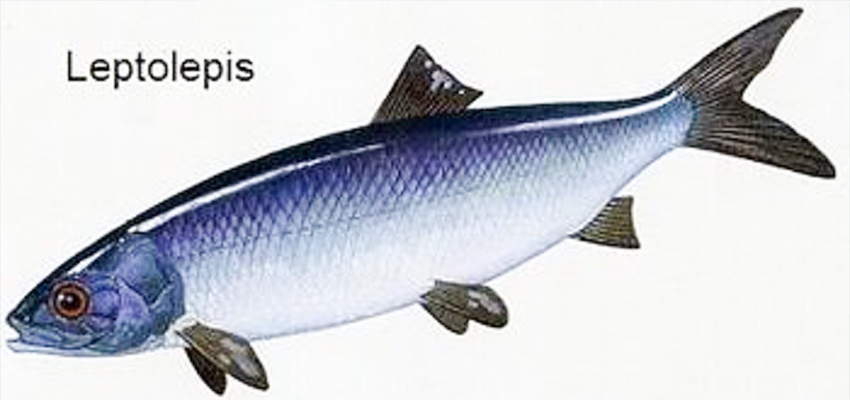
Although it looks fairly common and unremarkable, Leptolepis is among the most extraordinary fish that ever lived. It is believed that Leptolepis’ length was up to 8.5 centimeters only and It lived from 112 to 242 million years ago, which meant that it lived around for 130 million years. Another exciting property about Leptolepis is that evidence suggests that it was the first true bony fish, meaning that its bones came one before those of ray-finned fish in general. There is no evidence suggesting that there were Ray finned fish before Leptolepis.
8Megapiranha
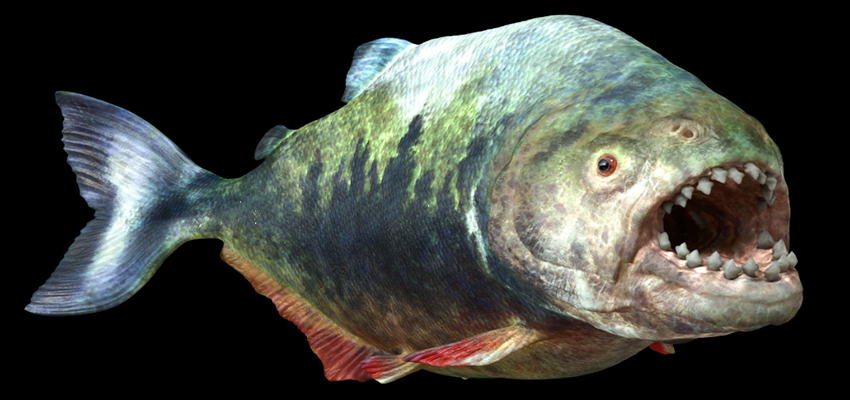
The Megapiranha is a recently extinct fish from the Late Miocene of Argentina. The holotype only contains premaxillae and zigzag teeth; the rest of its body is unknown. This resembles both the double-row teeth seen in pacus and the single row seen in modern piranhas, suggesting that it is a transitional form.
It was an intermediary between the size of today’s Piranha and Larger than 73 kg as some specimens can be as long as 95–128 cm, while they are assumed to have been proportional to their smaller cousins P. melanosoma, thus making it very unlikely it still had a mouth bigger than their current one.
9Dunkleosteus
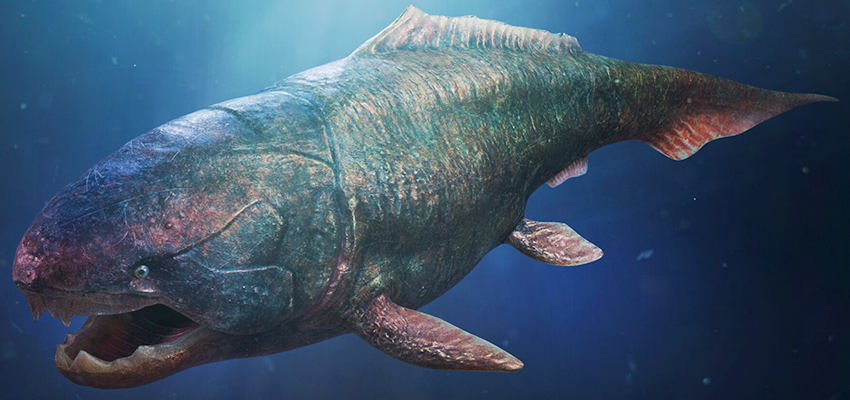
One of the largest and most powerful prehistoric fish that ever lived in the Devonian Period, Dunkleosteus has been declared one of the top predators. An arthodire, Dunkleosteus is an early jawed fish that originated from Northeast Ohio around 382 millions years ago. Three hundred fifty-eight million years ago, a shallow sea teeming with marine life covered Northeast Ohio where this fossilized vertebrate ruled its waters. More accurately, it was an arthrodire, with powerful shearing jaws and able to concentrate a force up to 7400 N.
Up to 33 feet in length and weighing more than 1 ton, Dunkleosteus was armed with sharp bony plates at the front of its jaw that could transform into self sharpening blades when it closed its mouth. The beast was capable of chopping up some of the biggest predators on Earth such as sharks.
10Coelacanths
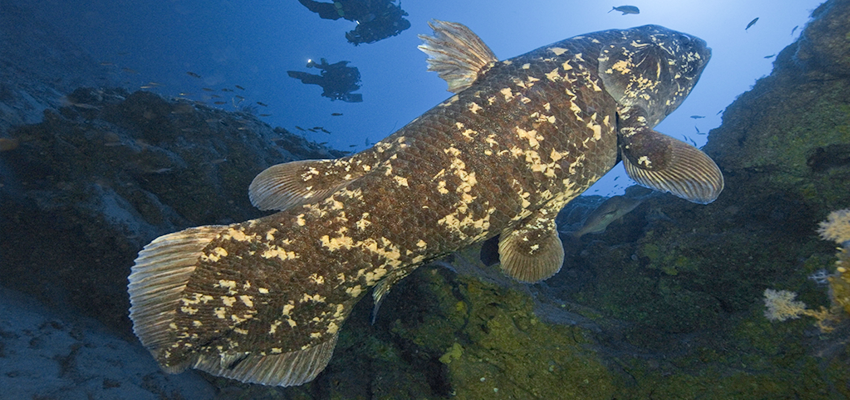
Coelacanths are a group of ancient fish first described in 360 million years ago. It was believed to go extinct 66 million years ago, but was rediscovered 1938 off South Africa’s coast near the mouth of the Mississippi River. Further investigation has shown that Coelacanths are more closely related to tetrapods than any other ray-finned fish. Coelacanths can grow to be 6.6 feet long, with just under 90 kilos and a lifespan of 60 years or more.
Rather than being carnivorous, they hunt at night and consume primarily Cephalopods such as squids, along with smaller fish and crustaceans. Though these fish are considered “passive drift feeders,” meaning they assume a position beside currents where prey can come, Coelacanths have also been proven to hunt and take down larger prey such as porpoises and seals.
11Sturgeon
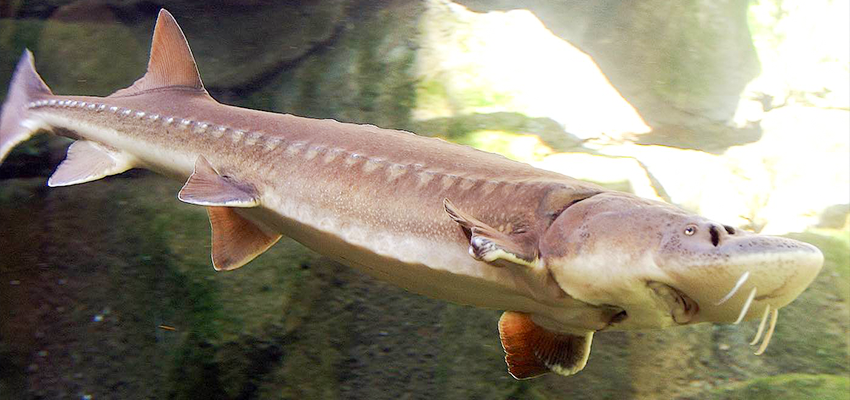
Sturgeons are now some of the most remarkable freshwater species in sub-arctic to temperate regions, who live more than a century and which first appeared during the early Jurassic period. Studied in prehistoric times, their body is made up almost entirely of cartilage. Their scales are patterned by protruding scutes and because they lack teeth, adults only feed off of tiny organisms.
The largest Sturgeon species (Acipenser fulvescens) grows to over 2.1 meters and can live for a century. This magnificent species is found in lakes that have cool and calm water as well as biologically productive benthic zones. With illegal harvesting of their eggs, many populations of this species have struggled to persist.
12Arapaima

The Arapaima is a notable Cretaceous period fish that can grow as long as 10 feet and is highly valued as a food source. The Arapaima has earned itself the distinction of being one of the largest freshwater odonates, with its torpedo-shaped body, tough composition, air breather capability and green to red scales. Extensive protection over a flexible layer of skin protects an armored exterior while they navigate through Amazonian rivers.
Fossils dating back 23 million years provide evidence as to how conserved and unique these fish’s features are. Unfortunately, the current status of their species may be quite opposite what they were once upon existence.
13Lamprey

There are more than fifty species of extant Lampreys, and many of them prey on other fish. They have been around for 300+ million years and display a similar form to their ancestors. Lampreys are typically jawless, worm-like creatures that evolved from fish with a sucking disk. These terrifying creature would be prime candidates if they existed as vampires who could live in the water. Lampreys have developed powerful suction capabilities so they can cling to rocks and stay still or go through currents. They’ve also evolved to eat plants like algae and some scientists believe they may eventually develop a taste for meat again.
At first glance, you might mistake a lamprey for an eel because it has long extensions and no fins. But if you look closely, you will see its unique gill pores, dorsal fin, or tooth-filled mouth cavity beneath its head.
14Sawfish

The Sawfish is perhaps one of the most easily identifiable prehistoric fish due to its tooth-like jaws, which broadened from its skull. It first appeared between 59 and 62 million years ago and highlights a shark-like flattened appearance. The Sawfish’s saw is not actually attached to its mouth; it’s located on the underside of its head up next to two small eyes that are set on either side of the head. Also known as carpenter sharks, Sawfish are among the largest of all cartilaginous fish species and can measure up to 23 feet in length.
Sawfish use their saws, which can measure in length up to 1/4 – 1/3 the body’s length, to capture and stab their prey. While they do exist as villainous creatures in age-old myths, they don’t often seek out humans for prey due to their ‘Saw’ (tooth) which is a natural extension of its skull.
15Dinosaur Eels
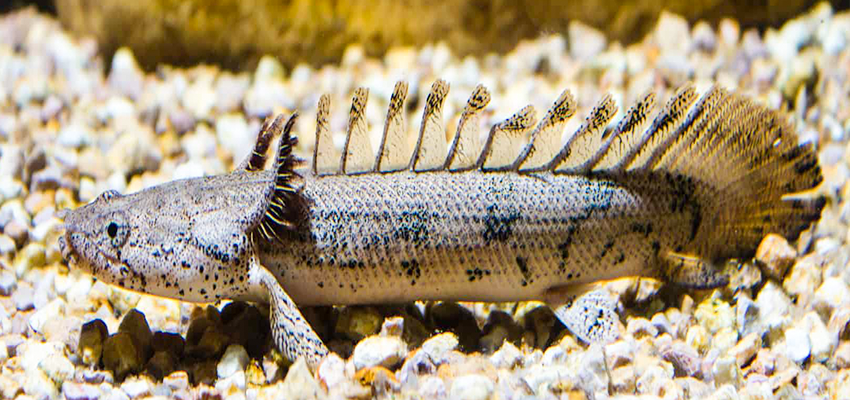
A fish that may appear prehistoric with its primitive features, the Dinosaur Eel is sought after to be seen as a curious aquaculture specimen. The Dinosaur Eel is a freshwater fish with economic value in the ornamental aquaculture industry, which can be readily bred in captivity as a bottom feeder. The fish spends most of its day perching on the tank floor or swimming actively. It also has a mouth like suction and can consume virtually any type of prey and swallow anything.
This freshwater fish, known as a “bichir”. As it is able to defend itself from predators with its scales, it should not be housed with valuable small fish in tanks with ample space. Its external nostrils give it an appearance that’s almost calm while its neutral position allows people to equate it to freshly caught prey. This elongated fish is mostly active during the day and uses suction to eat small crustaceans, invertebrates and vertebrates. Lastly, they are covered with scales which protect them from predators.
16Alligator Gar
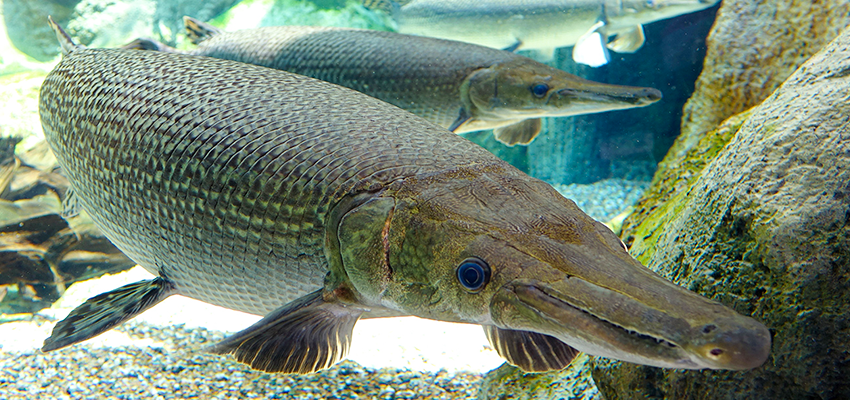
The Alligator Gar is an ancient fish with a variety of commercial purposes and interesting features. It can grow to a length of 10 feet, but most mature individuals are 6 feet and weigh up to 300 pounds. It belongs to a group of fish that first emerged during the early Cretaceous period. They’re similar to Alligators in some ways: their jawline and rows of teeth resemble those of an Alligator, for example.
This intriguing fish has armor-like scales and jaws like an alligator. It can even breathe, just like real Alligators. The alligator gar also has a unique feature only found in primitive types of fish or sharks – the spiral valve intestine.
17Frilled Shark
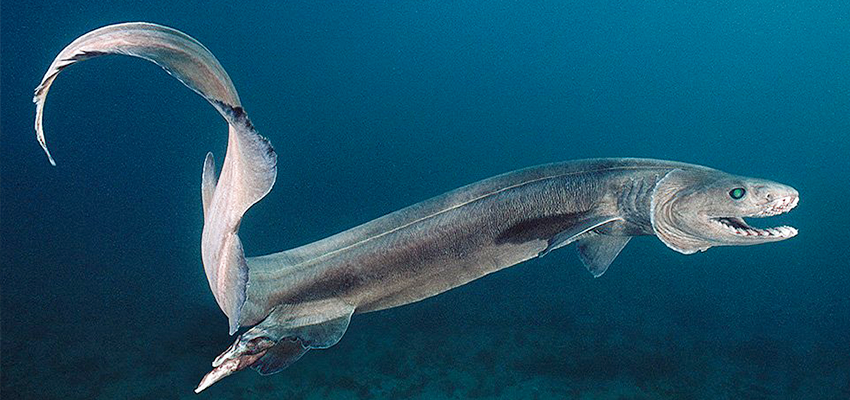
This Shark is known for its soft, Frill-like appearance of its gill filaments. This helps protect the long pairs of gills. Peculiar looking and elusive at night due to its preference, the Frilled Shark has a long body shape like an eel. It can measure up to 6.5 feet (2 meters). Primitive in nature, the species is typically dark brown in color and has jaws articulated to their cranium. These sharks date back to the Cretaceous period in which they inhabited shallow bodies of water as well. Collectively these features contribute to its status as primitive sharks.
These sharks usually stay close to the seafloor near zones with abundant food sources; they prefer continental shelves and slopes to feed closer to cephalopods that migrate there at night. While hunting, they are able to move stealthily and quickly— almost like an eel—and use a row of intricately curved teeth which serve as a trap to catch their prey after which they may swallow them whole.
18Arowana
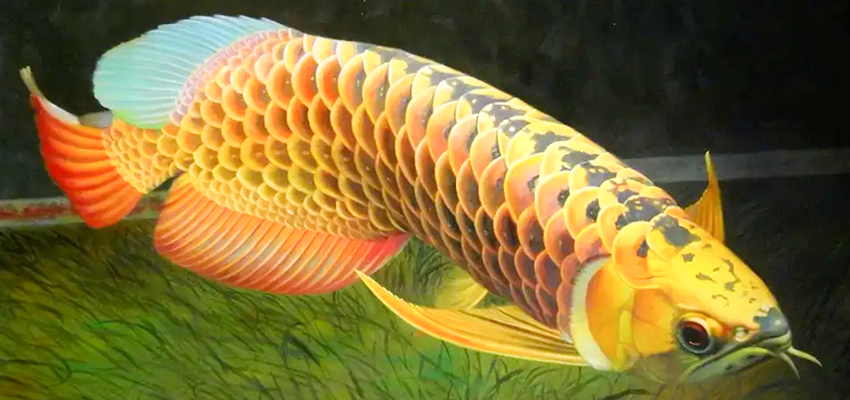
One of the most popular fish for aquariums, the Arowana is famous for its shiny scales, intricately organized or soft body, incredible colors and slender fins. The aggressive fish needs plenty of space and care, and should not be housed with smaller species. It can grow as long as 3 feet (1 meter) in an adequately-sized freshwater tank. The Arowana is a prehistoric fish that diverged from an ancient clade of Asian and Australian fish dating back 170 million years. These bony scales are cumbersome for the modern scaled fish group, ranging in size from 2cm. The Arowana thrives in blackwater rivers rich with tannins, where they feed on the surface of water and fly through the air to catch prey. Hence, it is sometimes referred to as “water monkey.”
19Lancetfish
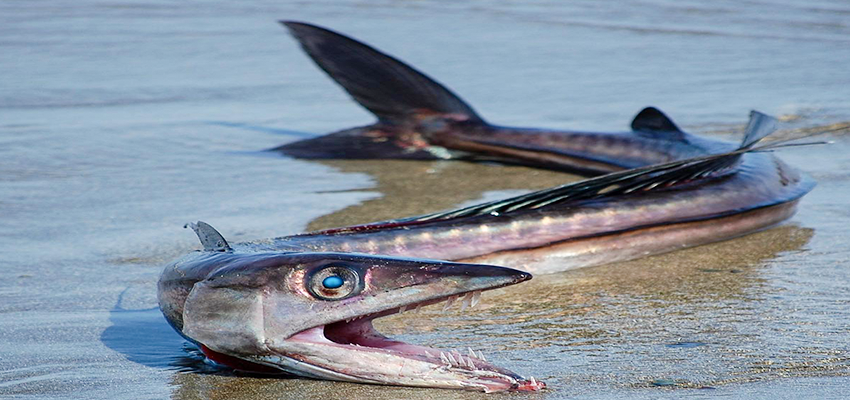
Lancetfish have a set of Greek words that, when translated together, mean “scaleless Lizard”. They have large mouths with high dorsal fins, and they look very similar to some wide-ranging desert reptiles. The prey of the Lancetfish can be many types, their appetite for just about any live organisms in the water column. They are known for being able to hunt with impressive accuracy and speed. Though Lancetfish may seem bizarre to those who do not understand them, they are a predator who hunts widely. There are currently two recorded remaining species of Lancetfish; the short-snouted Lancetfish and the long-snouted Lancetfish.
20Hagfish
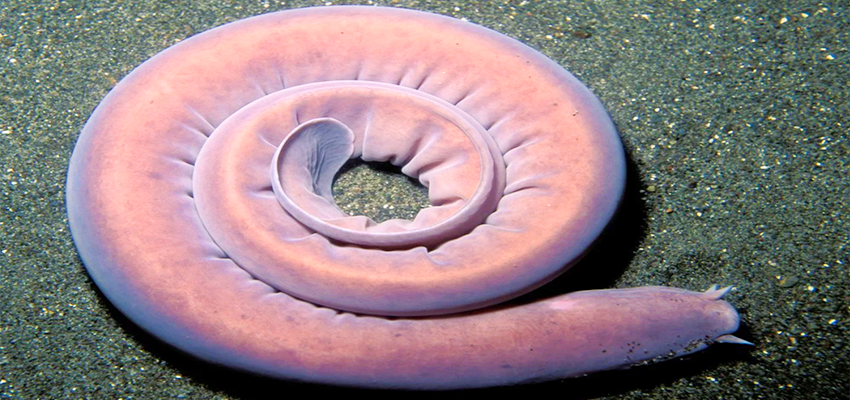
If a fish with no bones, slime, and a weird looking body has ever caught your attention, it’s the hagfish. Hagfish, also known as slime eels, are often considered one of the most unappealing animals in the ocean and may be likened to lampreys. They are vertebrae-less and don’t have a columnar backbone. Hagfish are 300 million years old and they are not eels or worms.
Hagfish will also be important when trying to understand how the vertebrate nervous system developed over time since it is an anomaly among modern day fish species. They defend themselves against predators by producing slime and possess one of the lowest blood pressures among all living fish.
21Hybodus
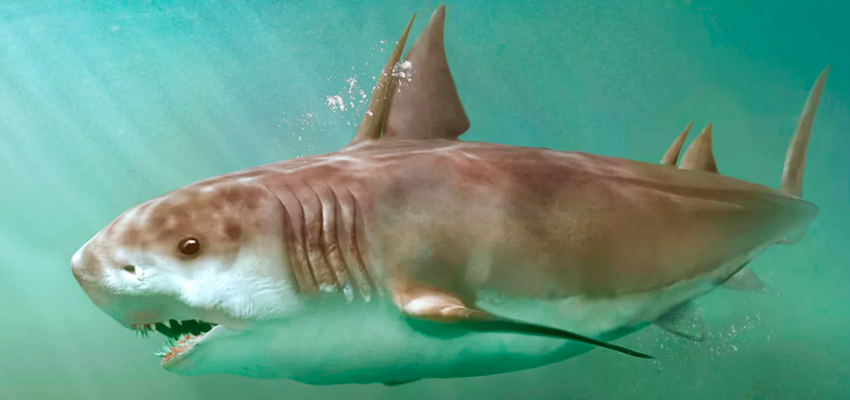
An extinct genus of shark, Hybodus, lived in North and South America, Africa, Europe and Asia from the Late Permian to the Late Cretaceous. The fossil record says that they are likely opportunistic predators. They were not very large and had a torpedo shape as well as upwards facing fins for stabilization in water. They often ate prey with their small jaws rather than specializing on one type of prey.
They had two types of teeth, serrated teeth and flat crushing teeth, suggesting that they had a diverse diet. They often survived by catching slippery prey in their sharp teeth, while crushing shelled animals with their leveling teeth. In addition to this shape specialization, the shark had spines on the back that helped protect it from the other sea creatures.
22Stethacanthus
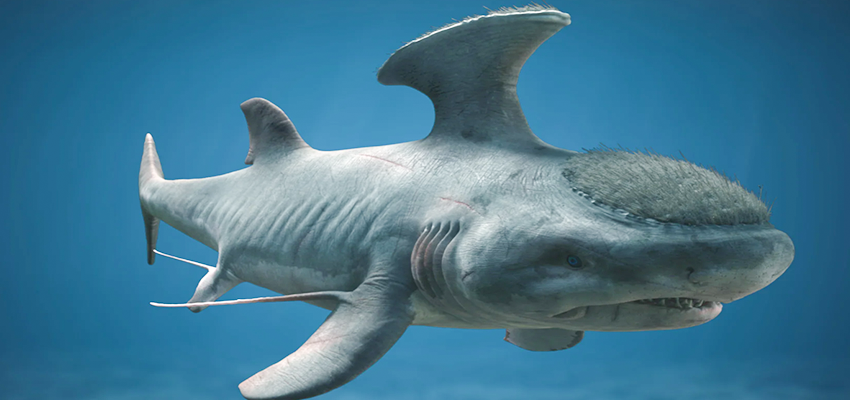
Stethacanthus is an extinct shark, living 360 million years ago in the Devonian and Carboniferous periods. They measure around 70 centimeters (2.3 ft) in length and closely resemble a typical shark but with an unusually-shaped dorsal fin resembling that of an anvil or ironing board.
The name Stethacanthus derives from the Greek στῆθος (stēthos), meaning “chest”, and ἄκανθος (akanthos) meaning “spine” or “thorn”. This creature likely hunted smaller vertebrates such as small fish. This shark also had small spikes on its skin which scientists think may have been used for self defense.
23Tiktaalik
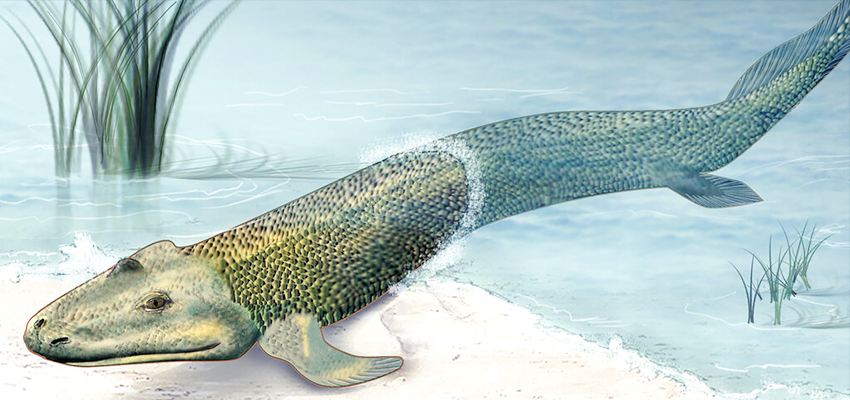
In 1938, the discovery of Latimeria chalumnae was used to “shot down” evolution. Creationists thought that lobe-finned fishes were evolving into tetrapods, but the presence of some lobe-finned fishes with “basic” exterior morphology seemed to show that such a transition did not happen. After the discovery of Tiktaalik in 2004, it was shown that while technically a lobe-finned fish, its limbs could be used to support itself in shallow water.
While some lobe-finned fishes did not make the transition (Tiktaalik), others did (the coelacanth). It is likely that Tiktaalik lived in swampy environments, likely moving through streams and ponds or crossing land when necessary to get into a new aquatic location.
24Cladoselache
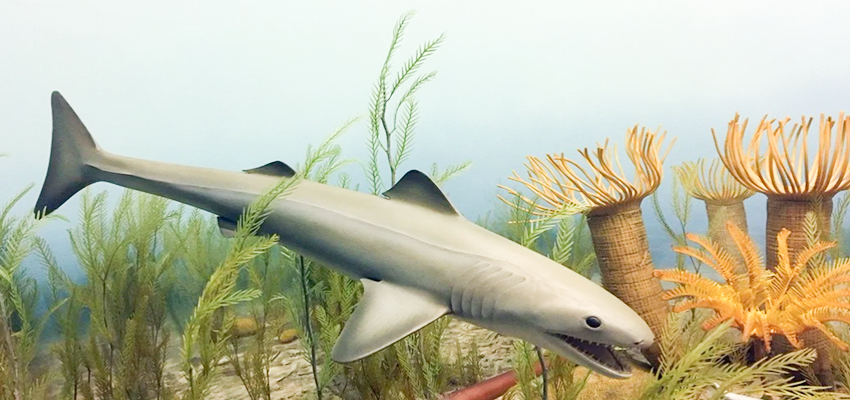
Cladoselache, ancestor of sharks, lived during the Late Devonian in North America and had a streamlined body with 5-7 gills, rounded snout and terminal mouth. The jaws could not open very wide but because the muscles were very strong, it compensated by swallowing its prey whole. The fins were sturdy but lightweight and these helped with speed and agility. Analysis of teeth have found that Cladoselache swallowed its prey whole primarily.
Cladoselache’s teeth are multi-cusped and smooth-edged, made for grasping food rather than tearing it apart or chewing it. The fin spines were sturdy yet lightweight. A blade-like structure rested on the anterior of the dorsal fins which helped with agility and speed making Cladoselache faster than predators like Dunkleosteus which was much larger.
25Carcharocles Megalodon
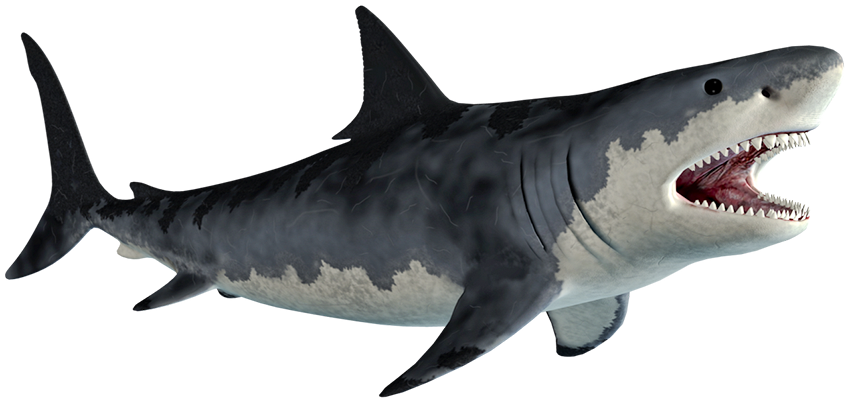
Carcharocles Megalodon is an extinct prehistoric shark that lived approximately 18 million years ago, and became extinct about 1.5 million years ago. It was the predator of the Miocene to Pleistocene epochs and is the largest carnivorous fish known to have existed, possibly even the largest shark in all of history.
Carcharocles Megalodon can grow up to 15 meters (49 feet) long. Fossil evidence has found that this species ate large marine mammals for food, and there is a major disagreement among scientists about whether or not it is an ancestor of the current white shark – even if they do have some similar teeth, these similarities are due to convergent evolution.